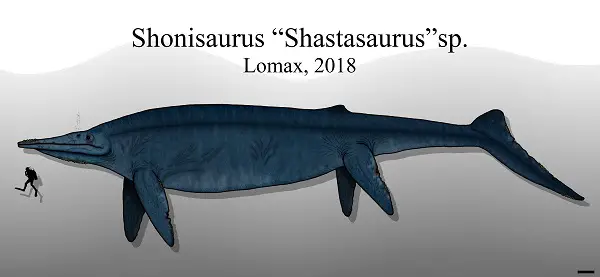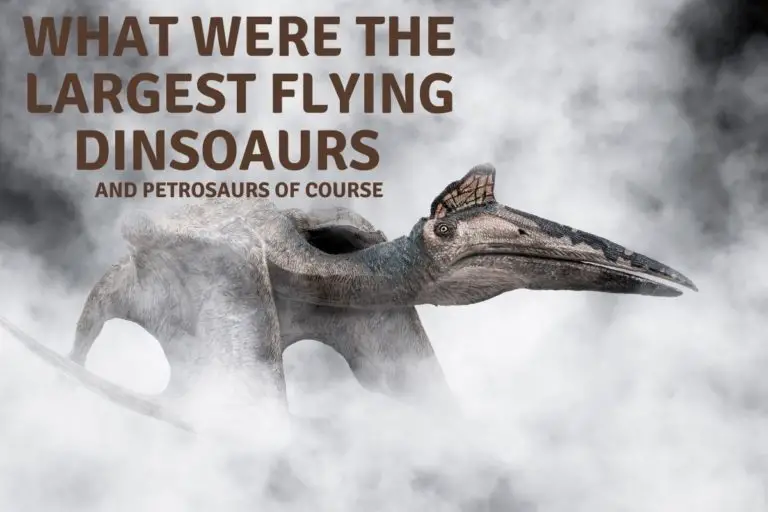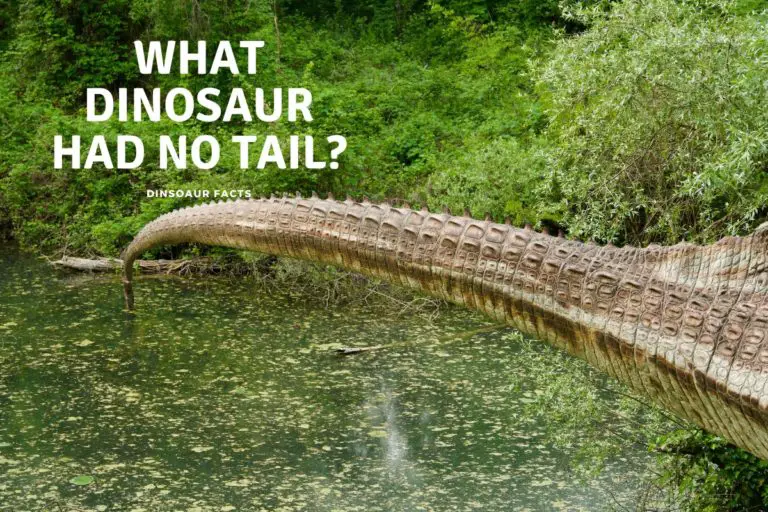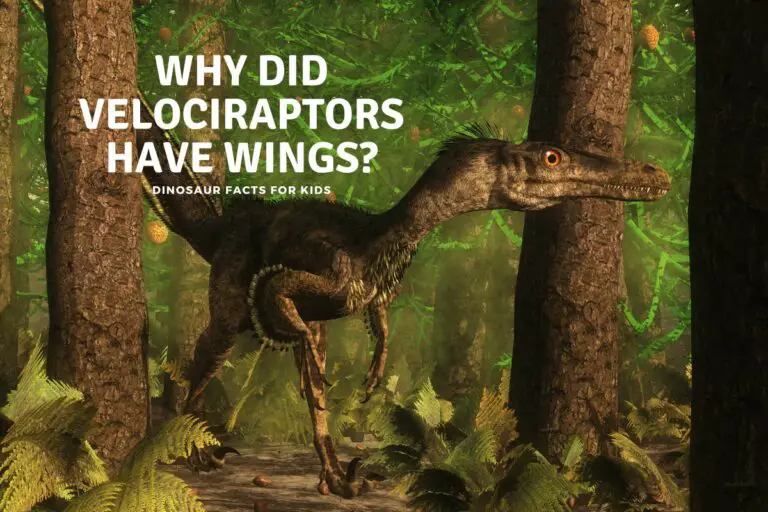What Were The Biggest Water Dinosaurs
When it comes to dinosaurs, we think of massive beasts that roam the land, such as a T-Rex. However, what about water? Is there such a thing as a water dinosaur? If there are, what were the biggest water dinosaurs?
Some of the biggest water dinosaurs are Mosasaurus, Shastasaurus, Tylosaurus, Elasmosaurus, and Shonisaurus. They belonged to different families of reptiles and existed in different periods during the dinosaur age. The largest marine reptile ever discovered is a Shonisaurus at upwatds or 80 feet and 150,000 lbs.
Snippet
This article will discuss if water dinosaurs exist and review some of the most giant sea reptiles during the age of the dinosaurs.
When you think of a water-dwelling dinosaur, what is the first thing that comes to mind? Is it some manner of plesiosaur? If so, then you should think again! The first thing we should point out, as we have mentioned in our other blog posts, is that technically no contemporary water-dwelling reptilian creatures of the late Cretaceous, Jurassic or other periods were technically dinosaurs.
While we may think of them all as such — not to mention being essentially told by a certain Hollywood film franchise that they are all one and the same — the water-dwelling giant reptiles of these eras were not technically dinosaurs
The term “dinosaur” is used by experts to refer to land-dwelling creatures with an upright stance (as opposed to a sprawling stance like that of a crocodile or similar reptile), and those whose skulls had a hole between the eye socket and nostril.
In this article, however, for simplicity’s sake, we will refer to the animals we do as water dinosaurs, but just remember that if you want to get technical or strict about it, they weren’t! We’re going to be taking a closer look at some of the largest water dinosaurs to ever swim the Earth.
Are There Water Dinosaurs?
Paleontologists agree that, in general, there are no water dinosaurs but marine reptiles. This is because dinosaurs are generally reptiles with four legs and are land-based. Marine reptiles are sea-based and can swim. They are split into three major groups, the Plesiosaurs, Ichthyosaurs, and Mosasaurs.
Scientists agree that there is no such thing as water dinosaurs. This is because a Dinosaur, by definition, is a land-based reptile with four legs. Some walk with all four legs, while some, such as the T-Rex, walk with only their hind legs.
This immediately discards sea-based creatures as dinosaurs. As a result, they are called marine reptiles instead. They differ from common fish in that they have to come up to the surface to breathe air, and some drag themselves to land to lay eggs.
The closest’ water dinosaurs’ would be the Spinosaurs. Still, it is mainly a land-based dinosaur that habitually entered the water to hunt for prey. It does not live permanently in the oceans.
water dinosaurs and Marine reptiles are usually split into three types, the Plesiosaur, Ichthyosaur, and Mosasaur.
Plesiosaur: Plesiosaur marine reptiles usually have flippers to swing around. They may have long or short necks. They also come up to land to lay eggs. You may imagine a turtle as its modern day ( in appearance) counterpart without the shell.
Ichthyosaur: Ichthyosaur marine reptiles are much more adapted to the sea. It still comes up to the surface to breathe and does not lay eggs but gives birth to babies. You may imagine a dolphin looking reptiles.
Mosasaur: Mosasaur marine reptiles came after the decline of both the Plesiosaur and Ichthyosaur. Like Ichthyosaurs, they give birth to their offspring instead of laying eggs. You may imagine Mosasaurs as giant aquatic lizards.
What Were The Biggest Water Dinosaurs?
The largest currently known water dinosaurs are ichthyosaurs with the largest being provably the shastasaurus, and the most like largest a species of ichthyosaur discovered in the swiss Alps in 2022 with a tooth twice as large as any discovered previously. this would make it the largest water dinosaur, and challenge the size of the blue whale.
| Name | Type | Period | Diet | Length |
| Mosasaurus | Mosasaur | Cretaceous | Fishes, other sea creatures | 50 feet (15m) |
| Shastasaurus | Ichthyosaur | Triassic | Fishes, cephalopods | 65 feet (20m) |
| Tylosaurus | Mosasaur | Cretaceous | Fishes, sharks, smaller mosasaurs, plesiosaurs, birds. | 50 feet (15m) |
| Elasmosaurus | Plesiosaur | Cretaceous | Fishes, shellfishes | 34 feet (10m) |
| Shonisaurus | Ichthyosaur | Triassic | Fishes, squid, octopus, small reptiles | 85 feet (26m) |
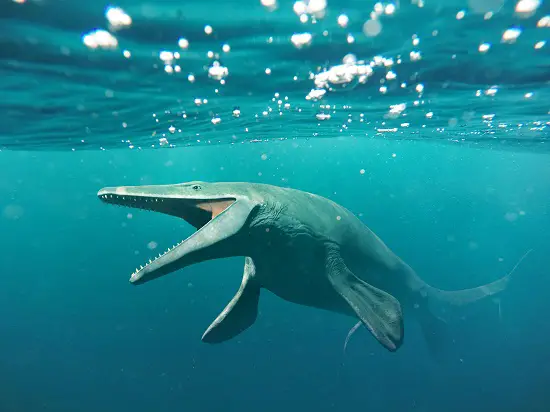
Mosasaurus
The Mosasaurus was a giant aquatic lizard that lived in the area that would become the North Atlantic Ocean. It lived at the tail end of the Cretaceous period. It was named after the river Meuse, where the first fossil was found in the Netherlands, which is where this great marine reptile was first described back in 1764.
You may feel you sense something familiar about this beast, and as well you might because it was featured in the Jurassic World movie series mosasaur, although in reality it was much smaller. Even so you can see why many people this of them as water dinosaurs.
Unlike the film depiction, however, where a 100-foot long Mosasaur is seen emerging from the water to take prey in a Seaworld-type display, the real largest Mosasaur was about half the size, 50 feet in length, which would still be pretty terrifying if you saw one swimming under your little fishing boat.
One more difference between real-life Mosasaur and those in the film was its skin. The film shows it as hard and scaly, like Godzilla. In reality, evidence shows that it had skin much more like that of a snake, and that it had a caudal fin more like a shark’s.
The largest species of Mosasaur could grow to be more than 50 feet long, with a streamlined head full of teeth and a long, muscular tail. It had two sets of fins. Early paleontologists thought that the Mosasaur might have been an ancient crocodile or monitor. Still, it turned out to be a completely different species that had nothing to do with modern animals.
The Mosasaurus are primarily carnivorous and eat fish and other sea creatures. Fossils of Mosasaurus were found in places like the Center-Loire Valley in France, South Dakota, and Nebraska have found its fossils.
Shastasaurus
Shastasaurus is perhaps the best example of a ‘gentle giant’ in the age of dinosaurs. It is an ichthyosaur, which is much more suited to live underwater than a plesiosaur. Shastasaurus lived in the seas of the late Triassic period. Shastasaurus was also known to have roamed around the coasts of the northern Pacific, as well as China.
Shastasaurus was a very large marine reptile dating back to the late Triassic period. In fact, to date it is the largest marine reptile that has been found, as is actually a genus of the above-mentioned Ichthyosaur family. The largest species was Shastasaurus sikanniensis, which grew up to 21m in length, or 69 feet. You can also read more about Shastasaurus in our facts page here and below. there were huge “water dinosaurs”
If it was an Ichthyosaur, why separate it and give it its own place in the list? Besides its unique size, Shastasaurus was known to be a particularly slender Ichthyosaur, and a type of specialist suction feeder. Furthermore, it had a toothless snout, unlike most Ichthyosaurs.
Despite appearances, it’s important to remember that Ichthyosaurs were reptiles, and not mammals or fish. However, it is also commonly believed by scientists that these creatures did give birth to live young rather than laying eggs as is more typical for other reptile species.
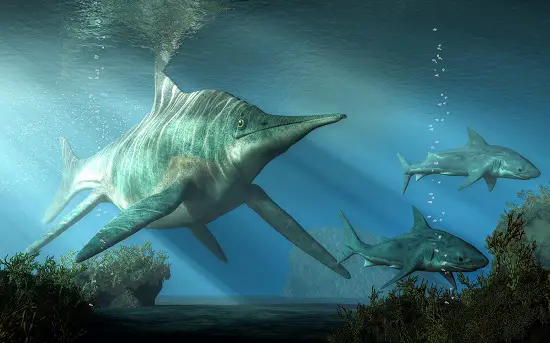
Ichthyosaurs
Ichthyosaurs were a family of marine reptiles ranging from 1 to 20 meters in length that lived from the early Triassic period to the late Cretaceous. They evolved from a species of land reptile that returned to the water in a similar way to what the ancestors of whales and dolphins have done in our more modern epochs.
While size varied, as mentioned above, the average size of an Ichthyosaur was about 2-4m (6.6-13.1 feet). In many ways, the later and more evolved Ichthyosaurs resembled dolphins, having a porpoise-like build and long snout. Skull remains have shown examples of such elongation, along with large eye sockets.
This group hoses the largest of all the water dinosaurs, and with further research some of these water dinosaurs amy turn out to be the biggest animals ever to live on the planet.
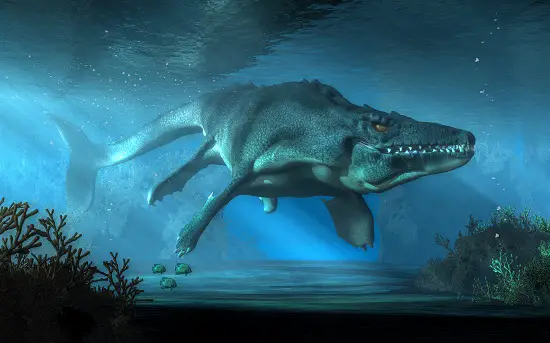
Tylosaurus
Tylosaurus were a group of large mosasaurs that lived in the late Cretaceous era. Some Tylosaurus were at least 50 feet (15m) long. Tylosaurus has the appearance of a giant sea lizard and is known to be an ancient cousin of modern monitor lizards and snakes.
Fossils of Tylosaurus have been found in North America, Europe, New Zealand, and, most recently, Antarctica. This suggests that they lived all over the world. Stomach contents from their fossils also indicated that Tylosaurus ate many different kinds of smaller animals, including other mosasaurs and plesiosaurs.
Shonisaurus
Shonisaurus may have been the biggest ever marine reptile, with a fossil found in 2016 indicating that it may have reached the size of 85ft (26m) long. Shonisaurus lived In the late Triassic period, between 237 and 201 million years ago. It could have weighed up to 150,000 lbs an would have but it in a similar size bracket as the Blue whale ( we have articles comparing these sizes here)
The snouts and flippers of Shonisaurus were usually longer and thinner than those of most other ichthyosaurs. They were skinnier and slimmer as well. Paleontologists suggested that instead of being an apex predator, they probably ate smaller animals, like small to medium-sized fish, squid, octopus, and other small reptiles.
However recent discoveries in 2022 of Ichthyosaurus teeth that are double the width of previously found fossils have suggested that there may be a truly huge water dinosaur waiting to be further uncovered.
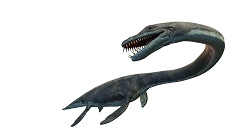
Plesiosaurus
We have the well-known Plesiosaur family, which we mentioned in the introduction of today’s blog. These creatures lived in the early Jurassic period, and were distinguished by its smaller head, long and slender neck, and broad body with elongated paddles.
English pioneer paleontologist Mary Anning was credited with the discovery of the first complete Plesiosaur skeleton back in 1823. It measured about 3m in length but could sometimes grow larger to 3.5m (11 feet), and upon its discovery was often referred to as “near lizard” because it was closer to the appearance of a more modern reptile than the likes of the Ichthyosaur family.
Perhaps one of the things that has helped make the Plesiosaur so prominent in the minds of many is its association with the mythical Loch Ness Monster so not only a possible group of water dinosaurs but also monsters as well!
Believers of the myth sometimes posit that the world-famous creature is in fact some kind of Plesiosaur that has managed to survive and breed in the loch for all this time especially with those pictures of it long neck, which leads us onto ….

Elasmosaurus
Elasmosaurus belongs to the family of plesiosaurs and has been estimated to reach approximately 34 feet (10m) long. It has a streamlined body, with legs shaped like flippers to move its huge body around, similar to a turtle. They are, however, known for their extremely long necks, with their necks covering over 70% of their total length.
Elasmosaurus is known to feed on fishes and many other small sea creatures. Most paleontologists proposed that Elasmosaurus may have given birth to their offspring instead of laying eggs. Fossils of Elasmosaurus have been found in the central continental United States.
Largest-Ever REAL Water Dinosaur
Contrary to what we said in the introduction, we do have an actual dinosaur, namely Spinosaurus. If it’s a dinosaur, then didn’t it live on the land? In fact, it did, but scientists already know for a fact that Spinosaurus did eat fish and other aquatic prey, and actually was semiaquatic itself in nature, finding happy lodgings in both water and on land, not unlike modern crocodilian animals.
The first remains of Spinosaurus were found in 1912 as a partial skeleton, and the genus was named in 1915 by German paleontologist Ernst Stromer. Since then, there have been 6 partial specimens described, the first of which was that of Stromer in 1915, the holotype. This was unfortunately destroyed during World War II as the British bombed Munich in April 1944.

According to descriptions, Spinosaurus could grow up to 15m in length (49.2 feet), but incomplete findings mean that this isn’t absolutely confirmed. If confirmed, it would help Spinosaurus’ case to be dubbed both the longest and largest of the theropod dinosaurs, and that includes the likes of Tyrannosaurus rex and others.
As its name suggests, one of the most prominent features of Spinosaurus were its neural spines that were up to 1.65m in length and bound together with tight skin to form a sail-like structure. Some postulate, however, that these were actually surrounded by fat and it formed a kind of hump. It remains thought of as the largest theropod dinosaur to date, and its semi aquatic nature just makes it all the more interesting.
We have a series of articles on How Big Dinosaurs were and you can follow the links below to check out the size of other popular dinosaurs.
And if you wanted to know some of the smallest dinosaurs ever you can check out the article on the site as well. As although dinosaurs are often thought to be huge monstrous animals there were plenty of small ones as well and we take a look at them on the link above.
Conclusion
As we mentioned water dinosaurs is a misnomer ( an incorrect name) however as long as you know that we can use the term. The largest of these water dinosaurs were the shastasaurus and the shinosaurus and most likely if more fossils can be discovered the owner of the 6 centimetres (2.5 inch) tooth found in the Swiss alps! twice the width of any other tooth previously found.
It is likely, we think that just like on land, the water dinosaurs will be found to have the largest of any animals on Earth, we just need to keep digging!
References
- https://www.cbc.ca/news/science/biggest-ichthyosaur-1.4612537#:~:text=Scientists%20said%20on%20Monday%20this%20ichthyosaur%2C%20which%20appears%20to%20be,part%20of%20its%20lower%20jaw.
- https://www.trtworld.com/life/largest-ever-tooth-of-ancient-marine-reptile-discovered-in-alps-56720
- https://www.livescience.com/largest-ichthyosaur-tooth#:~:text=Measuring%20about%202.3%20inches%20(60,Himalayasaurus%20tooth%2C%20the%20researchers%20said.
Hi, I am Roy Ford a General Studies and English Teacher who has taught all over the world. What started as a fossil collection became a great way to teach, motivate and inspire students of all ages and all over the world about dinosaurs and from that and children’s love of dinosaurs came the site dinosaur facts for kids, a resource for all ages.

